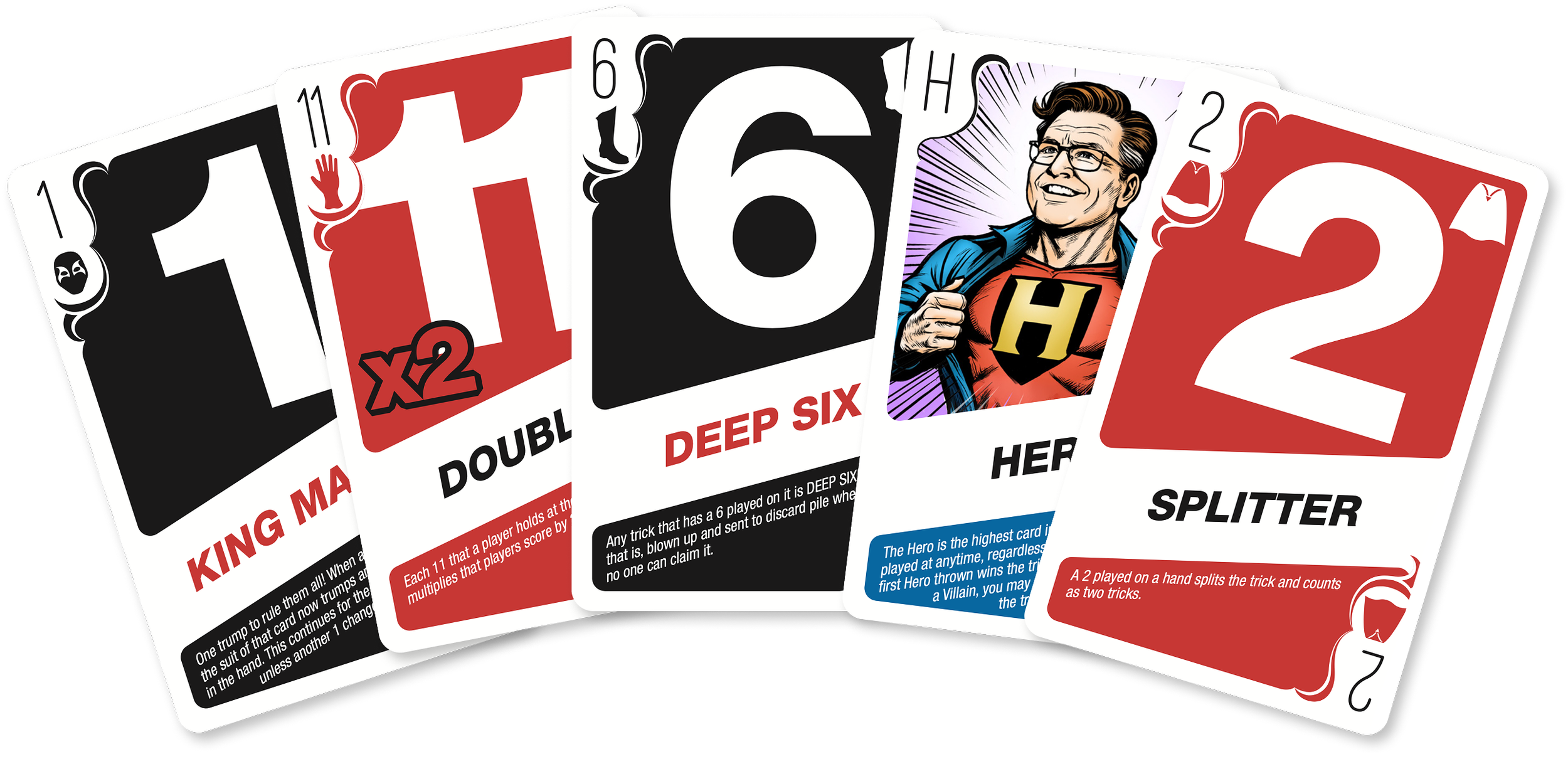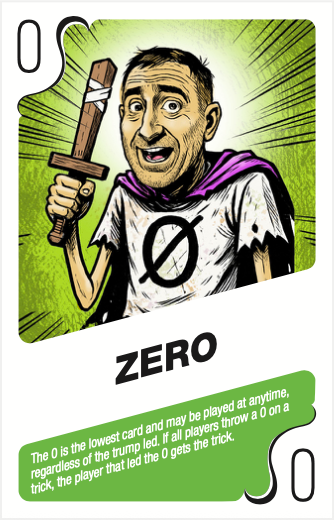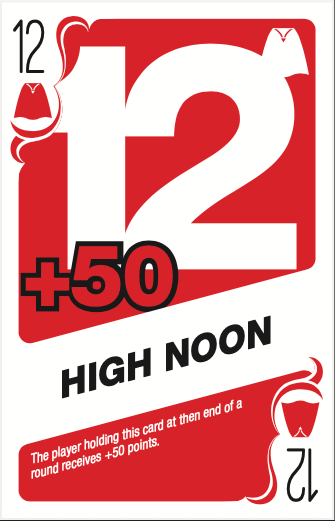A Game of Heroes, Zeros & Villains
-
This is a card game designed for 2 to 10 players, with the optimal number being 4–6. That’s where the magic happens.
Each game round involves dealing cards, making bids, playing tricks, and scoring points. One player is selected as the Dealer and another as the Scorekeeper, who keeps score for the entire game.
GAME COMPONENTSStandard deck includes:
4 Suits of cards numbered 1–12:
Red Capes
Red Gloves
Black Masks
Black Boots
3 Specialty Cards:
Hero
Villain
Zero
ROLESDealer: Deals cards and manages the flow of the round.
Scorekeeper: Keeps track of all players’ scores throughout the game.
STARTING A ROUNDA Round begins when cards are dealt and ends when all tricks have been played and won.
The Dealer starts by dealing one card face down to each player, beginning with the player to their left and moving clockwise.
The number of cards dealt per player is determined before the round begins, depending on the game style.
OBJECTIVEThe goal is to score points by winning tricks and to prevent others from scoring.
What is a Trick? A Trick occurs when:
All players play one card.
The highest-ranking card wins the trick.
The number of cards in each player's hand determines how many tricks will be played in that round.
Example: 4 players with 6 cards each = 6 tricks in the round.
BIDDINGAfter cards are dealt, each player bids the number of tricks they believe they will win that round.
Bidding starts with the player to the left of the dealer and continues clockwise.
The total number of bids does not need to match the number of tricks.
There can be more or fewer tricks bid than available.
Scorekeeper should record each players bid.
PLAYING TRICKSThe player to the left of the dealer plays the first card of the first trick.
The suit of the first card played determines the trump suit for that trick.
Other players must follow that suit if they have a matching suit. If not, they may play any other suit or a specialty card.
CARD RULES & HIERARCHYSuits (Groups)
Must follow suit if able.
Trump suit is the one that matches the first card played in a trick.
Specialty Cards - Can be played at any time, regardless of suit:
Zero
Villain
Hero
Card Strength (Lowest to Highest)
Zero
Numbers 1–12
Villain
Hero
Example: If the first card is a 2 of Red Capes, Red Capes becomes the trump for that trick. All players must play a Red Cape card if they have one or may play a special card instead.
WINNING TRICKSThe highest-ranking card according to the suit or specialty card hierarchy wins the trick.
Tricks are placed face-up in front of the player who won them, fanned out to be visible.
POINTS SYSTEMIf you bid 0 tricks and you win 0 tricks you receive 20 points. For every trick you get when you bid correctly, you get 10 extra points. EX. you bid 3 tricks and got 3. You get 50 points. However if you don’t get what you bid, you lose 10 pts for every trick you were off by. EX. you bid 3 but got 2, you receive -10 pts. OR You bid 1 trick but got 4 tricks, you receive -30 pts. Determining how you are playing, either by number of rounds you play or by time, the one with the most points at the end wins.
-
ALL CARDS HAVE POWERS!
You can’t have a superhero game without some super powered cards, and all the cards in the game have some special ability.
H - HERO
The Hero card is the highest card in the game. He is all powerful and conquers all. There are 4 in the deck. This card trumps all others. In a case where 2 or more Hero cards are played in one trick, the first Hero laid is top card.V - VILLAIN
The Villain card is the Second highest card in the Deck but he has an especially evil ability. If a player wins a Trick and it contains a Villain, that trick must be given to a player other than the one that won the trick. There are also 4 in the deck.0 - ZERO
The Zero card is weak and wimpy, the complete opposite of the Hero. It is the lowest card in the deck. You play this when you don’t want to win a trick. But be careful. If all cards played in a trick are Zeros, the first zero played wins the trick. 4 in the deck.1 - KING MAKER
One color to rule them all! When a 1 is played, the suit of that card now trumps any other colors in the hand. This continues for the whole round unless another 1 card changes color (trump).2 - SPLITTER
A 2 played on a hand splits the trick in half and counts as two tricks. And odd number of trick cards will still be divided in two tricks. EX. 5 cards = a stack of 2 and a stack of 3.3 - THIRD EYE
When a player lays a 3 on a trick they are allowed to view the hand of any one player for a count of 3.4 - FOUR’AGER
A player may exchange their 4 with another card in their own book of tricks to play on the current trick. (book of tricks is any previous trick you have won that round)5 - FIVE FINGER DISCOUNT
A player may exchange their 5 with another card in another players book of tricks to play on the current trick.6 - DEEP SIX
Any trick that has a 6 played on it is DEEP-SIXED, that is, blown up and sent to discard pile where no one can claim it. The player that played the highest card in the Deep-Sixed trick must lead out to start the next trick.7 - LUCKY SEVEN
A 7 can be played as a Hero or a 0. It must follow color rules and only turns into a Hero or 0 after the player declares it. A 7 may also be played as a 7 of its color.8 - ACCUMUL’EIGHT’ER
When an 8 is played on a trick that trick remains on the table. The person with the high card of that trick must lead the next trick. The winner of the next round gets both tricks.9 - NEIN!
A player that plays a 9 may choose that their 9 is a 0 or that any other players laid card is a 9 0. Cards played after the players cannot be changed. 9s can also be played as a 9 of that color. NEIN! A player that plays a 9 may choose that their 9 is a 0 or that any other players laid card is a 0. Cards played after the players cannot be changed. 9s can also be played as a 9 of that suit. Changing another cards number only affects the card to determine the trick. After the trick is won, that card reverts back to whatever it was and gets back whatever power and point value that it had.10 - DE’TEN’TION
A player that wins a trick containing a 10 may select any player (themselves included) to sit out the next trick. The player sitting out must discard a single card during the turn face down at the start of the turn. De’ten’tioned players can not be given a Villain won trick.11 - DOUBLER
Each 11 that a player holds at the end of a round multiplies that players score for the round by 2. EX. Player bids 2 tricks and gets 2 tricks containing two 11 cards. 40 pts. x 2 x 2 = 160 pts. or EX, Player bids 3 tricks but gets 4 with three 11s in those tricks... -10 x 2 x 2 x 2 = -80 pts.12 - MIDNIGHT or HIGH NOON
The player holding this card at then end of a round receives bonus points. Black cards are Midnights -50 pts. Red cards are High Noon +50 pts. -
BASIC GAME
(Recommended for beginners)
The Basic Game is played without number card powers activated. You can just ignore the rules on the 1-12 cards and only play them as numbers/suits. It starts with a single card dealt to each player in round one. 2 Cards are dealt to each player in round two. 3 Cards dealt in round three and so on until you get to the round where all the cards in the deck have been dealt so each person has the same amount. After that final round the scores are tallied and a winner is declared.ESCALATION
(This is the classic game)
ESCALATION is the basic game but the number card powers are activated gradually. Essentially, you are activating the powers of one of the 1-12 cards each time the dealer deals and the game now includes the new rules found on the bottom of the activated card. The activated power is generally chosen by using a regular card deck (1–Q) or a hand-made set that shows numbers 1–12. Each time the dealer deals, they draw a new card from your power activation deck and place it face up. Whatever number is showing activates the powers of that card. This builds over time and you keep the previous power cards activated until either they are all activated or the game ends—whichever comes first.
Example: Dealer deals new round of cards and then draws/flips over a 5 from your 1–12 cards. Now it is no longer just a 5, it now also has the “5-finger discount” power activated. The next round, the dealer deals and flips over a 1. Now the 5-finger discount is still activated AND so is the 1 ”King Maker” card. The powers build on each other and change the dynamics of the game as it goes along… or “Escalates”, if you will.ESCALATION WITH A TWIST
(Classic game with more flavor)
Dealing out 4-5 cards is good starting number for this variation. This is just like regular ESCALATION, but instead of 1 power activated in round one, 2 or more powers are activated. This gives the game quick jolt and a better chance of players getting an activated power card in their hand. Each round begins with flipping over another power card and adding that power to current group of powers.
Tip: You can also decide at the beginning that you want to start the game with specific powers. Example: “Let’s start by activating 4, 5, 11, and 12”ARMAGEDDON
(For nihilists and more seasoned players )
This game starts with all powers activated and all playing cards dealt out. The number of rounds you play should be determined before you start. Don’t pick a high number of rounds, as each round will take some time as all outcomes are calculated by player on every turn.OTHER RULES
The game rules are mostly to keep order amongst the chaos and they are not perfect. You may have a scenario where the play a of card may not have a clear outcome of a trick. In this case use your best judgment and talk it out with other players in the game. You may get to a point where you have had enough and the game must end. There is no shame in stopping a game but you should do it after a round has been finished so you can tally the scores and determine a winner. -
How long does a game take?
That depends on the number of players and how many rounds. A four player Escalation game may take an hour or more to finish. It all depends on the speed of your decision making. Beginning rounds with only a card or two go very quickly where later rounds with 10 cards or more in your hand take time.Do all powers have to be used?
Absolutely not. If the group dislikes a certain power, simply don’t activate that one. The beauty of this game is that you can make it your own.
The Power is in Your Hands.
Click a card to see its abilities once activated.

















